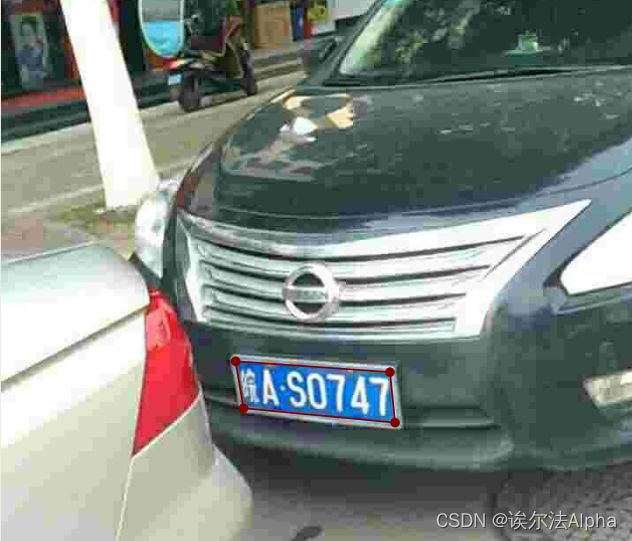车牌识别数据集(蓝牌、黄牌、绿牌)及相关转换代码
自己整理了一些用在车牌识别的数据集,已经人工一张一张的筛选过了,过滤掉模糊的图片、处理有歧义的区域,可以直接采用。
label为labelme的json格式,目标框是polygon多边形,好处是不同角度的车牌都能完全贴合,如图。

整理了三类车牌,分别是蓝牌、绿牌、黄牌(直接点击即可下载)。
若是要进行yolo的目标检测训练,可用以下代码进行转换为yolo的darknet格式:
import json
import os
import shutil
import cv2
import os
from numpy.lib.twodim_base import triu_indices_from
import pandas as pd
from glob import glob
import codecs
print(cv2.__version__)
def getBoundingBox(points):
xmin = points[0][0]
xmax = points[0][0]
ymin = points[0][1]
ymax = points[0][1]
for p in points:
if p[0] > xmax:
xmax = p[0]
elif p[0] < xmin:
xmin = p[0]
if p[1] > ymax:
ymax = p[1]
elif p[1] < ymin:
ymin = p[1]
return [int(xmin), int(xmax), int(ymin), int(ymax)]
def json2txt(json_path, midTxt_path):
json_data = json.load(open(json_path))
img_h = json_data["imageHeight"]
img_w = json_data["imageWidth"]
shape_data = json_data["shapes"]
shape_data_len = len(shape_data)
img_name = os.path.split(json_path)[-1].split(".json")[0]
name = img_name + '.jpg'
data = ''
for i in range(shape_data_len):
lable_name = shape_data[i]["label"]
points = shape_data[i]["points"]
[xmin, xmax, ymin, ymax] = getBoundingBox(points)
if xmin <= 0:
xmin = 0
if ymin <= 0:
ymin = 0
if xmax >= img_w:
xmax = img_w - 1
if ymax >= img_h:
ymax = img_h - 1
b = name + ' ' + lable_name + ' ' + str(xmin) + ' ' + str(ymin) + ' ' + str(xmax) + ' ' + str(ymax)
print(b)
data += b + '\n'
with open(midTxt_path + '/' + img_name + ".txt", 'w', encoding='utf-8') as f:
f.writelines(data)
def txt2darknet(midTxt_path, img_path):
data = pd.DataFrame()
filelist = os.listdir(midTxt_path)
for file in filelist:
file_path = os.path.join(midTxt_path, file)
filename = os.path.splitext(file)[0]
imgName = filename + '.jpg'
imgPath = os.path.join(img_path, imgName)
# for path in img_path:
# imgPath = os.path.join(path, imgName)
# if not os.path.exists(imgPath):
# continue
# else:
# break
if not os.path.exists(imgPath):
imgName = filename + '.png'
imgPath = os.path.join(img_path, imgName)
if not os.path.exists(imgPath):
imgName = filename + '.jpeg'
imgPath = os.path.join(img_path, imgName)
img = cv2.imread(imgPath)
print(imgPath)
[img_h, img_w, _] = img.shape
data = ""
with codecs.open(file_path, 'r', encoding='utf-8',errors='ignore') as f1:
for line in f1.readlines():
line = line.strip('\n')
a = line.split(' ')
if int(a[5]) - int(a[3]) <= 15 or int(a[4]) - int(a[2]) <= 15:
img[int(a[3]):int(a[5]), int(a[2]):int(a[4]), :] = (0,0,0)
continue
if a[1] == 'other' or a[1] == 'del':
img[int(a[3]):int(a[5]), int(a[2]):int(a[4]), :] = (0,0,0)
continue
if a[1] == 'plate_p': # blue
a[1] = '0'
elif a[1] == 'green_plate': # green
a[1] = '1'
elif a[1] == 'yellow_plate_s': # yellow
a[1] = '2'
x1 = float(a[2])
y1 = float(a[3])
w = float(a[4]) - float(a[2])
h = float(a[5]) - float(a[3])
# if w <= 15 and h <= 15: continue
center_x = float(a[2]) + w / 2
center_y = float(a[3]) + h / 2
a[2] = str(center_x / img_w)
a[3] = str(center_y / img_h)
a[4] = str(w / img_w)
a[5] = str(h / img_h)
b = a[1] + ' ' + a[2] + ' ' + a[3] + ' ' + a[4] + ' ' + a[5]
print(b)
data += b + '\n'
with open(saved_path + '/' + filename + ".txt", 'w', encoding='utf-8') as f2:
f2.writelines(data)
json_path = "/data/license_plate/blue"
midTxt_path = "/data/license_plate/blue/mid"
img_path = "/data/license_plate/blue"
saved_path = '/data/license_plate/save'
if not os.path.exists(midTxt_path):
os.mkdir(midTxt_path)
filelist = os.listdir(json_path)
for file in filelist:
old_dir = os.path.join(json_path, file)
if os.path.isdir(old_dir):
continue
filetype = os.path.splitext(file)[1]
if(filetype != ".json"): continue
json2txt(old_dir, midTxt_path)
txt2darknet(midTxt_path, img_path)
shutil.rmtree(midTxt_path)
如果想要矩形rectangle形状的目标框的json格式,再用以下代码转换:
# -*- coding: utf-8 -*-
import json
import cv2
from glob import glob
import os
txt_path = '/license_plate/save/' # darknet格式
saved_path = '/data/license_plate/json/'
img_path = '/data/license_plate/blue/images/'
files = glob(txt_path + "*.txt")
# files = os.listdir(txt_path)
# print(files)
files = [i.split('/')[-1].split('.txt')[0] for i in files]
print(files)
for file in files:
print(file)
txt_file = txt_path + file + '.txt'
img_file = img_path + file + '.jpg'
if not os.path.exists(img_file):
img_file = img_path + file + '.png'
if not os.path.exists(img_file):
img_file = img_path + file + '.jpeg'
print(img_file)
img = cv2.imread(img_file)
# print(img)
imgw = img.shape[1]
imgh = img.shape[0]
xi = []
yi = []
xa = []
ya = []
Label = []
with open(txt_file, 'r') as f:
for line in f.readlines():
line = line.strip('\n')
a = line.split(' ')
label = 'other'
if a[0] == '0':
label = 'plate_p'
elif a[0] == '1':
label = 'green_plate'
elif a[0] == '2':
label = 'yellow_plate_s'
Label.append(label)
print(Label)
centerx=float(a[1])*imgw
centery=float(a[2])*imgh
w=float(a[3])*imgw
h=float(a[4])*imgh
xmin = centerx - w/2
xmax= centerx + w/2
ymin= centery - h/2
ymax = centery + h/2
xi.append(xmin)
yi.append(ymin)
xa.append(xmax)
ya.append(ymax)
# for j in range(0, len(files)):
labelme_formate = {
"version": "4.2.9",
"flags": {},
"lineColor": [0, 255, 0, 128],
"fillColor": [255, 0, 0, 128],
"imagePath": os.path.split(img_file)[-1],
"imageHeight": imgh,
"imageWidth": imgw
}
labelme_formate['imageData'] = None
shapes = []
for i in range(0, len(xi)):
s = {"label": Label[i], "line_color": None, "fill_color": None, "shape_type": "rectangle"}
points = [
[xi[i], yi[i]],
[xa[i], ya[i]]
]
s['points'] = points
shapes.append(s)
labelme_formate['shapes'] = shapes
json.dump(labelme_formate, open(saved_path + file + ".json", 'w'), ensure_ascii=False, indent=2)
print(saved_path + file + ".json")
欢迎私信一起学习交流!